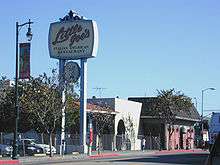Little Joe's
| Little Joe's Italian American Restaurant | |
|---|---|
 The former Little Joe's Italian American Restaurant | |
| Restaurant information | |
| Established | 1928 |
| Closed | 1998 |
| Food type | Italian-American |
| Street address | 904 North Broadway |
| City | Los Angeles |
| County | Los Angeles |
| State | California |
| Postal code/ZIP | 90012 |
| Country | United States |
| Coordinates | 34°3′51″N 118°14′13″W / 34.06417°N 118.23694°WCoordinates: 34°3′51″N 118°14′13″W / 34.06417°N 118.23694°W |
Little Joe's Italian American Restaurant was a historic Italian restaurant which once stood in the Chinatown district of Los Angeles, California USA at the corner of Broadway and College Street. The area was once part of the city's Italian American enclave, which preceded Chinatown.
History
Italian-born Charles Viotto started a grocery store at the corner of 5th and Hewitt streets. Robert Nuccio took over that store after marrying Charles Viotto's daughter, Mary, and in 1895 renamed it The Italian-American Grocery Company. In 1923, Robert Nuccio (the youngest of 12 children) took his children Chel and John back to Italy, to talk his family into moving to America. When he did that, he sold the grocery to his friends down the street, and it was purchased by John Gadeschi & his friend, Joe Vivalda. They moved the grocery store to North Broadway in 1927. When Union Station began construction, the Italian immigrants building it began coming by the grocery store for lunch and John started making them sandwiches. The rough-hewn nature of the Italian laborers started keeping the ladies away from their shopping, prompting John and Joe to open an adjacent restaurant so that the men could go about their lunch breaks while the women could do their shopping undisturbed.
When Italy sided with Axis powers in World War II, many Italian businesses changed their names; one famous example was the change in name from Bank of Italy to Bank of America. Subsequently, the Italian-American Grocery Company became Little Joe's after Joe Vivaldi. Little Joe's is not affiliated to any other restaurant that took the same name.
Gadeschi's daughter, Marion, married John Albert Nuccio - Robert's son - and, once again, the restaurant was back in the Nuccio family. John, who had been in law school at USC before the war, went to work at the restaurant for his father-in-law after serving in World War II. The business remained under control of the Nuccio family until it closed in 1998.[1]
Up until the closure, Little Joe's was operated by the third generation of Nuccio men: Steve, Bob and Jay. Jay went off on his own to open The Crazy Horse, a West Covina-based country-and-western bar and eatery. That left Steve and Bob to operate Little Joe's.
Closure
The restaurant closed in December 1998.[2] The owners, having waited for a revitalization of Chinatown and Downtown as a nighttime dining destination, decided that it was time to retire. With the revitalization of nearby Old Pasadena, it became more and more difficult for downtown establishments to compete for a dinner crowd.
As part of the revitalization movement of Chinatown, there are plans to turn the restaurant into a retail and residential hub with a large car parking structure. On December 2, 2013, Forest City Enterprises began demolishing Little Joe's to start the construction of a new $100 million real estate development. The Blossom Plaza project, in the works for over a decade, will feature a large-scale five story apartment building over ground level shops.[3]
The long-standing abandoned restaurant was finally demolished on January 17, 2014. When excavation began for the replacement project, a 100-foot-long (30 m) section of the Zanja Madre was found on the site. Water from the Los Angeles River was conveyed in this early water system for use by the original settlers of Los Angeles.[4]
References
- ↑ POOL, BOB (October 8, 1998). "After Many Years, Little Joe's Will Just Fade Away". Los Angeles Times.
- ↑ "Little Joe's". Old Los Angeles Restaurants. March 10, 2012. Retrieved April 14, 2015.
- ↑ Vincent, Roger (October 13, 2013). "$100-million complex to replace former Chinatown fixture". Los Angeles Times.
- ↑ Pool, Bob (April 21, 2014). "Workers discover part of L.A.'s first municipal water system". Los Angeles Times.